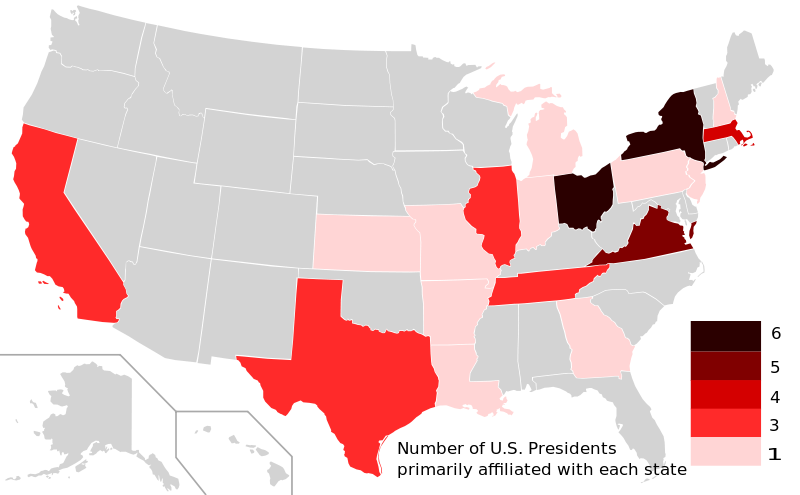A cursory glance at presidents listed by home state reveals a somewhat surprising statistic: seven presidents have called Ohio their home, and six of those were born there. Seven out of forty-three doesn't really seem like a fair share, especially considering that while Ohio's been one of the more populous states since the 1830s, it never managed a sixth of the country's population. So what's going on?
Looking at a list of the presidents by home state makes it a little more clear: from Ulysses S. Grant to Warren G. Harding, every president was from a swing state*. Looking at each election makes it even more clear; Republicans nominated someone from a swing state in every election from 1868 to 1920 (with the exception of James G. Blaine of Maine in 1884, which they lost), and Democrats did so a substantial majority of the time. Three of the four times they didn't were for William Jennings Bryan, who was a magnificent Nebraskan orator who nevertheless got spanked all three times. In 1920, both Warren G. Harding and James Cox were from Ohio.
So the answer is: for fifty years, both parties nominated people from swing states, and Ohio was a popular choice for the Republicans, who won most of those elections, albeit often narrowly. Ohio's dominance is, however, mitigated somewhat by Grant being an Illinois native, and it was listed as his home state in 1872. The delegates at the 1868 convention cannot have considered him to be an Ohioan, since three-term Ohio Senator had a plurality of votes for the vice-presidential nomination for the first four ballots, and nominating two men from Ohio would have denied them that state's votes in the Electoral College*. Grant still would have won easily without Ohio's 21 votes, since he beat Horatio Seymour of New York 214 votes to 80, but that's the election, not the convention.
Grant was nominated based not on his Ohio residency, which borders on the fictitious, but because he was seen as winning the Civil War. Garfield, in 1880, had served nine terms in the House, and was preparing to take a seat in the Senate, but was commonly addressed and referred to in the convention as General, since he had served as a Major General during the Civil War, and that title was seen as far more prestigious than a member of the House. Frankly, that's probably a pretty common opinion these days, what with Congress being literally less popular than diarrhea.
*New Jersey, New York and Indiana were swing states in the late nineteenth century, and Grover Cleveland lost reelection to Benjamin Harrison in 1888 because he couldn't keep the latter two states in his column. In fact, they were the only states to change sides from 1884 to 1888, and 1888 was also the first election since 1876 and the third ever in which the candidate who won the most popular votes didn't win the election.
*Each elector gets two votes, at least one of which must be cast for someone from a different state than his own. If both people on the ticket are from the same state, then the electors from that state cannot cast both votes for both people on the ticket. The most likely outcome in the case of a massive screwup like that, assuming one of the people on the ticket cannot hastily obtain legal residence in any other state, would have been for all the electors to vote for someone else for Vice President, since it was not a highly respected position back then, and losing that while winning the Presidency would have been very much preferable to the opposite.

No comments:
Post a Comment